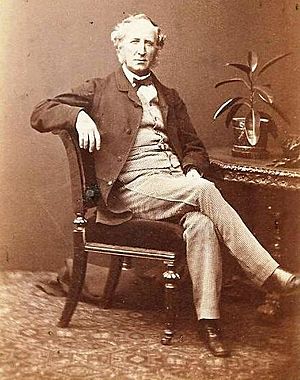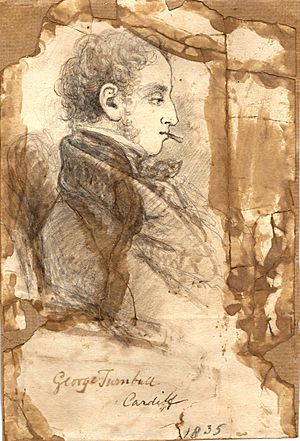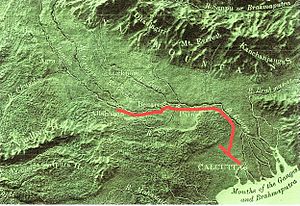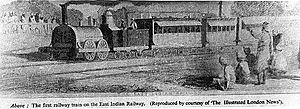George Turnbull (engineer) facts for kids
Quick facts for kids
George Turnbull
|
|
|---|---|
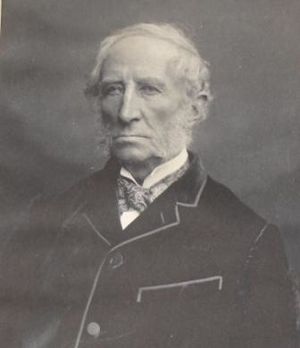
George Turnbull
|
|
| Born | 2 September 1809 Luncarty, Perth and Kinross (then Perthshire)
|
| Died | February 26, 1889 (aged 79) Rosehill, Abbots Langley, Hertfordshire, England
|
| Nationality | Scottish |
| Education | Perth Grammar School from 18 September 1819 Edinburgh University from 3 November 1824 |
| Occupation | Engineer |
| Spouse(s) |
|
| Children | Five by his wife Fanny Thomas .. two children died as infants in India |
| Engineering career | |
| Discipline | Civil engineer |
| Institutions | Institution of Civil Engineers 1838–1889 |
| Projects | East Indian railways;
West Bute dock, Cardiff; Middlesbrough Dock; Seacombe wall; Great Northern Railway (Great Britain) |
| Awards | In 1863 gazetted by the Indian Government as the "First Railway Engineer in India". He was also offered a British knighthood. |
George Turnbull was a Scottish engineer. He is famous for building India's first long-distance railway line. From 1851 to 1863, he oversaw the construction of the railway from Calcutta to Benares. This line ran alongside the Ganges river and was 541 miles (871 kilometres) long. Including branch lines, it stretched 601 miles. Later, the main line was extended to Delhi.
Turnbull led a huge team. He had about 100 British engineers and 118,000 Indian workers. All the railway parts, like tracks and engines, came from Britain by ship. Before the Suez Canal, these ships sailed all the way around Africa. Many materials then traveled up the Ganges river in Indian boats, even during heavy monsoon rains.
When the railway was finished, the Indian government called Turnbull the "First railway engineer of India." He was even offered a British knighthood, but he chose not to accept it.
Contents
Early Life of George Turnbull
George Turnbull was born in Luncarty, Scotland, in 1809. This village is about 5 miles north of Perth. He was the youngest of William and Mary Turnbull's eleven children.
In 1814, his family moved to Huntingtower village. His father successfully ran a linen factory there. George's grandfathers had also developed similar factories.
George was first taught by his older sister, Mary. From age 10, in 1819, he rode a pony to Perth Grammar School. In 1824, he went to Edinburgh University. There, he studied Latin, Greek, and mathematics. He also spent a year learning about linen manufacturing and bookkeeping from his father.
Engineering Career in England
In 1828, George Turnbull sailed from Dundee to London. He began training with the famous civil engineer Thomas Telford. They worked on building the St Katharine Docks. By 1830, Turnbull became Telford's assistant. He lived in Telford's house in London. At just 19, he joined the Institution of Civil Engineers. He later became its oldest member.
In 1832, Turnbull helped survey rivers to plan London's water supply. He studied rivers like the Colne and River Lea. In 1833, he worked on tests for fast passenger boats on the Paddington Canal. He worked with other important engineers like William Cubitt.
When Telford died in 1834, Turnbull helped with arrangements for his house and burial. Telford was buried in Westminster Abbey.
Turnbull was promoted to lead the building of the Bute ship canal and West Bute dock in Cardiff. He reported to William Cubitt and met regularly with Lord Bute.
In 1836, he visited Bristol to see the start of the Clifton Suspension Bridge. Another famous engineer, Isambard Kingdom Brunel, visited Turnbull in Cardiff in 1839.
Turnbull's diary from 1837 shows how hard travel was back then. He traveled from Cardiff to his parents' home in Scotland. This involved a mail coach, a long journey by coach through 10-foot deep snow, and a 41-hour steamer trip.
From 1840 to 1842, Turnbull built Middlesbrough Dock. This dock was later bought by the Stockton and Darlington Railway. In 1843, he worked on a railway line near Dover. He built a pier and landing stages at Folkestone. He even entertained the Duke of Wellington during this project.
In 1845, he worked in Birkenhead on the Seacombe Wall. This sea defense helped drain the marshy land behind the town.
From 1846 to 1849, he was a lead engineer for the Great Northern Railway (Great Britain). He built tunnels and made the first plans for King's Cross station.
Building India's First Main Railway
In 1850, George Turnbull became the Chief Engineer of the East Indian Railway. From 1851 to 1862, he built India's first major railway line. It stretched 541 miles (871 km) from Calcutta to Benares, on the way to Delhi. Including branches, it was 601 miles (967 km) long.
He designed Calcutta's main station, Howrah station. Today, it is one of India's busiest stations. Building bridges over the wide Sone River and other rivers was very difficult. These rivers were often flooded by monsoons.
Turnbull faced many challenges. There was not enough good clay or skilled local workers to make bricks. So, almost all the ironwork for bridges, rails, and engines had to be brought from England. India did not have steel factories then. Moving huge amounts of materials up the Ganges river was also hard. Simple "country boats" were used. During the Indian Mutiny, many boats were sunk, and materials were stolen. Diseases like Cholera also caused many deaths among the Indian workers and the English engineers.
Declining a Knighthood
George Turnbull was offered a British knighthood for his work in India. However, he turned it down. He felt he did not have enough money to live the lifestyle expected of a knight. He later regretted this decision, partly because it affected his future earning power.
Other Projects in India
In 1856, the Bengal Government asked Turnbull to be the Commissioner of Drainage and Sewerage. This meant he was in charge of improving Calcutta's water drainage and sewage systems.
In 1861, Turnbull became a member of the Syndicate of the Calcutta University. This group helped manage the university.
Also in 1861, the Peninsular and Oriental Steam Navigation Company hired Turnbull. He redesigned the Sulkea Dock in Calcutta and made its entrance wider.
In February 1868, Turnbull traveled to Bombay to help settle a claim. This claim was made by contractors who had built part of the Great Indian Peninsular Railway. He took a private train for four days to inspect bridges and culverts.
Personal Life and Retirement
In 1845, George Turnbull married Jane Pope in England. Sadly, she died of fever in Calcutta in 1850, just four months after arriving in India.
In 1855, he married Fanny Thomas, who was the niece of engineer William Cubitt. They married in Switzerland because of old laws in England. They had six children together. Two of their infants, Jane and Rose, died in Calcutta. Their children Ellen, George, Alexander, and Katie were born in Calcutta and London.
The family later retired to London and then to Rosehill in Abbots Langley, England, in 1875. George Turnbull was the Vice-Chairman of the Assam Tea Company. His younger son, Alexander, worked for this company in London and then in Assam, India. George Turnbull's wife, Fanny, passed away in 1903.
Contributions in Abbots Langley
George Turnbull used his engineering skills to help his local village, Abbots Langley. He wrote a plan for the Abbots Langley Water Company. He was also very involved in planning the village's drainage and sewage system in 1885.
The village church has a stained-glass window in his memory. It says, "To the Glory of God in memory of George Turnbull C.E. born 1809 died 1889." His wife, Fanny, donated it.
|


